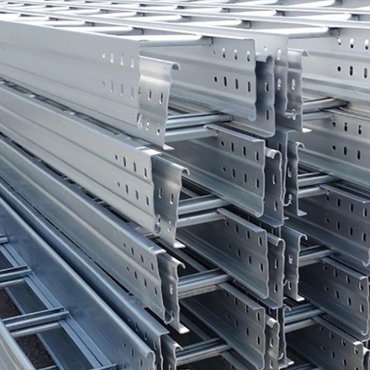Your Reliable Supplier of Cable Tray & Raceway in China since 2010
As a professional manufacturer of cable tray & raceway over 20 years, we are able to provide you a full range of products and used in industrial & commercial buildings, electric utilities, oil & gas and petrochemical sectors.
What is a Cable Tray & Raceway
Referring to NEMA & IEC standards, cable tray & raceway is mainly used to lay and protect wire & cable lines to avoid potential damage caused by external factors during operation. A rigid structure with cable support is composed of straight cable tray, tray elbow, tray tee & cross, supports and hangers. The three most common types of cable tray & raceway in the market are: channel cable tray, perforated cable tray and ladder type cable tray.
PowerTel & its associated factory will help you to select a proper type cable tray & raceway to fit your cable tray wiring system.
Cable Tray & Raceway by its materials
it is made of aluminum or aluminum alloy, galvanized steel, hot dipped steel, 316 stainless steel or fiber glass.
It is a fully enclosed cable tray, which is suitable for laying communication cable, thermocouple cable and other high-sensitive control cable. It has good effect on shielding interference of control cable and protection of cable in heavy corrosion conditions.
It has the advantages of light weight, large load, simple structure, convenient installation, good heat dissipation and permeability, etc. It is applicable to the installation of power cables and the laying of control cables.
It has the characteristics of light weight, good ventilation and heat dissipation. It is suitable for laying cables with large diameter, especially for laying high and low voltage power cables.



Necessary accessories to fix or to support the installation for Cable Tray & Raceway
Well-equipped with Manufacturing Facilities
From CNC Punching, Roll Forming, and Robotic Welding , with our well–equipped hot galvanized plant ,we used top–notch European–standard electronic control equipment and measuring devices to ensure adherence to various quality standards for our cable tray & raceway.


Fast Delivery Time
Having a large inventory, plus our big production capacity for cable tray & raceway, it allows us to have shorter production and delivery times, as we can quickly and easily modify our production rate based on the size of the order, which is quickly meeting and surpassing the expectations of our customers.
Custom Design & Fabrication for Your Cable Tray & Raceway
we understoond, you are always having some special requirement of these cable tray & raceway; With our extensive engineering and manufacturing capabilities, our engineering team is ready to work with you to develop a cable tray and raceway solution that meets your specific needs.

Related Product
Guide to select a proper cable tray & raceway
The cable tray & raceway in the building can be erected independently or attached to various buildings and pipe rack supports. It should reflect the characteristics of simple structure, beautiful appearance, flexible configuration, and convenient maintenance. All parts need to be galvanized. The cable tray & raceway installed outside the building in the open air, if located near the seaside or in a corrosive area, must have physical properties such as anti-corrosion, moisture resistance, good adhesion, and high impact strength;
Load for cable tray & raceway
The load of cable tray & raceway is divided into static load, dynamic load and additional load.
Static load refers to the type, number, outer diameter weight/unit length of cables laid in cable tray, which are listed and counted according to different routes of cable laying.
Dynamic load refers to the weight of construction and maintenance personnel during the installation and maintenance of cable tray. For light cable tray, dynamic load is generally not considered, that is, people are not allowed to stand or walk on the cable tray & raceway. If it is necessary to consider standing people, the span should be appropriately reduced.
The additional load only refers to the load formed by ice, snow, wind, and electromagnetic forces outdoors, which is related to the natural meteorological conditions of the installation site and the properties of the charged body. Calculation should be based on various conditions in the design.
Installation guide for cable tray & raceway
1. In engineering design, the layout of the cable tray & raceway should be comprehensively compared based on factors such as economic rationality, technical feasibility, and operational safety to determine the optimal plan. It should also fully meet the requirements of construction, installation, maintenance, and cable laying.
2. When the cable tray is horizontally laid, the height from the ground should generally not be less than 2.5m. When vertically laid, the part below 1.8m from the ground should be protected with a metal cover plate, except when laid in an electrical dedicated room. The cable tray & raceway shall be horizontally laid on the equipment interlayer or catwalk and less than 2.5m, and protective grounding measures shall be taken.
3. When using cable trays, trunking, and their supports and hangers in corrosive environments, they should be made of corrosion-resistant rigid materials or undergo anti-corrosion treatment. The anti-corrosion treatment method should meet the requirements of the engineering environment and durability. For places requiring high corrosion resistance or cleanliness, aluminum alloy cable tray should be selected.
4. In sections with fire protection requirements, cable ladders and trays can be added with fire-resistant or flame retardant materials such as boards, nets, etc. to form a closed or semi closed structure. Measures such as applying fire-resistant coatings to the surface of the cable tray and its supports and hangers should be taken, and its overall fire resistance performance should meet the requirements of relevant national regulations or standards. In places with high fire protection requirements, aluminum alloy cable tray should not be used.
5. Cable lines that need to shield electromagnetic interference, or have environmental requirements such as outdoor sunshine, oil, corrosive liquids, flammable dust, etc. for protection of external influences, shall use perforated tray cable tray.
6. In places prone to dust accumulation, cable tray shall be covered; In public passages or outdoor crossing road sections, it is advisable to add pads or use perforated trays on the bottom bridge.
7. Cables with different voltages and different purposes should not be laid in the same cable tray:
(1) Cables above 1kV and below 1kV:
(2) Double circuit cables supplying power to primary loads along the same path;
(3) Emergency lighting and other lighting cables:
(4) Power, control, and telecommunications cables.
If cables of different grades are laid on the same cable tray, partition separation shall be added in the middle.
8. When the length of the steel straight section exceeds 30m and the aluminum alloy cable tray exceeds 15m, or when the cable tray passes through the expansion (settlement) joint of the building, an 0 to 30mm compensation allowance should be reserved. The expansion connection plate should be used for its connection.
9. The selection of cable ladder and tray width and height should meet the requirements of filling rate. Generally, the filling rate of cables in the ladder and tray can be 40% -50% for power cables and 50% -70% for control cables.










